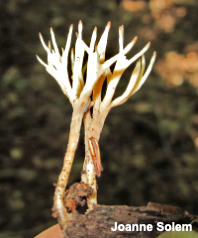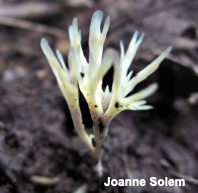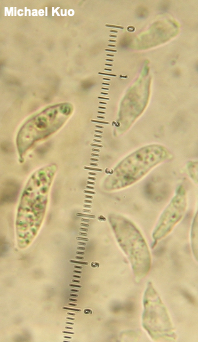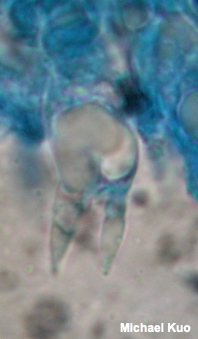| Major Groups > Clubs & Corals > Tremellodendropsis tuberosa |

|
Tremellodendropsis tuberosa [ Basidiomycota > Tremellodendropsidales > Tremellodendropsidaceae by Michael Kuo A small, whitish, sparingly branched coral fungus with a well-defined stem and, importantly for identification, tough flesh, Tremellodendropsis tuberosa is found across much of North America but appears to be most common on the West Coast and in the southern Appalachians, based on online records from our continent's major herbaria. Small, sparingly branched versions of Tremellodendron schweinitzii (AKA Tremellodendron pallidum) and other, less well-known species of Tremellodendron are very similar in appearance and are also tough-fleshed; these are best separated with microscopic examination. Additionally, many small and whitish coral fungi are superficially similar but have fragile, brittle flesh and are thus more easily separated. Tremellodendropsis tuberosa has been causing taxonomic problems since the day it was discovered. At issue is its placement relative to other groups of fungi. It has funky, interesting basidia (the prong-like structures on which spores are borne) that seem to be a combination of two well-established types. Jelly fungi develop divided basidia, while other mushrooms that bear spores on basidia do not. But the basidia of Tremellodendropsis tuberosa are partially divided; a crease develops at the base of the spore-holding prongs, creating a basidium type that has been called "partially septate," or "subtremellaceous." (I think they ought to be called "butt-crack basidia," since they look like, well, like your plumber, under your sink; see the illustration to the right.) Thus the very tiny genus Tremellodendropsis, and even a separate family to hold the genus, the Tremellodendropsidaceae, were created to hold this mushroom long before DNA studies—and the mushroom continues to confuse now that its DNA can be analyzed. The most recent work (Berbee and collaborators 2016) supports giving Tremellodendropsis its own order (the rank above family), the Tremellodendropsidales! Thanks to Joanne and Bob Solem for collecting, documenting, and preserving a collection of Tremellodendropsis tuberosa for study; their collection is deposited in The Herbarium of Michael Kuo. Description: Ecology: Ecological role uncertain; growing scattered to gregariously on the ground, sometimes from well-decayed woody debris, in woods; widely distributed in North America but apparently more common on the West Coast and in the southern Appalachians than elsewhere. The illustrated and described collection is from Maryland. Fruiting Body: A small, sparingly branched structure arising from a shared stem; about 4–6 cm high and 2–3 cm across. Branches: round or somewhat flattened in cross-section; dry; smooth and bald; dull yellowish white, with starker white tips when fresh; discoloring a little brownish with age, beginning with the tips. Stem: Smooth and bald; whitish to brownish. Flesh: Tough; whitish; not changing when sliced. Spore Print: White. Microscopic Features: Spores 15–20 x 4–7 µm; fusiform, subfusiform, or elongated-amygdaliform; smooth; hyaline in KOH. Basidia 2-sterigmate; to about 55 x 12.5 µm; clavate; sterigmata quite long, with thick bases; developing a cleft or crease at the bases of the sterigmata, in the apex of the basidium. Clamp connections present. REFERENCES: (Greville, 1825) D. A. Crawford, 1954. (Corner, 1953; Corner, 1966b; Arora, 1986; McNeil, 2006; Trudell & Ammirati, 2009; Desjardin, Wood & Stevens, 2015; Berbee, Wong & Tsui, 2016; Siegel & Schwarz, 2016.) Herb. Kuo 08081801. This site contains no information about the edibility or toxicity of mushrooms. |
© MushroomExpert.Com |
|
Cite this page as: Kuo, M. (2017, December). Tremellodendropsis tuberosa. Retrieved from the MushroomExpert.Com Web site: http://www.mushroomexpert.com/tremellodendropsis_tuberosa.html |



